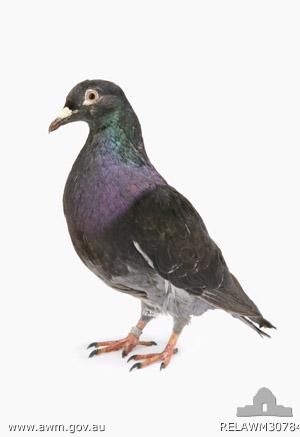Animals in war
An exhibition on animals in war will open at the Memorial in February 2009. A is for Animals will explore a range of themes relating to animals during times of war. The exhibition will explore stories of the Light Horse; the donkeys, camels, horses and other creatures used to transport soldiers and equipment; the pigeons used to carry messages; the dogs who have located injured soldiers and tracked the enemy, and the many and varied animals adopted as mascots and pets. Additionally the exhibition will consider the unwelcome animals in war, such as insects, rats, wild elephants and jungle dwellers, which can make life difficult or even dangerous.
Blog posts highlighting some interesting stories and collection items will appear throughout the year in the lead-up to the opening. Here's a taster.

Pigeons
The use of pigeons for communications in war can be traced back to the classical era. The unique advantages of the homing pigeon as a method of communication are that it is silent, difficult to intercept, not significantly affected by gas or noise and can be trained to home to mobile lofts.
Pigeons were used in great numbers during the First World War. However, as technology, including the radar, wireless and telephone, had greatly advanced since then, by 1939 it was thought that pigeons would no longer be required. Nonetheless, it was soon realised that this equipment could still fail in certain situations and message-carrying pigeons were reinstated as an alternative.
In 1942, the threat of enemy invasion of Australia led civilian pigeon-fanciers to voluntarily establish a network that could carry messages in the event that radio contact failed. Later that year the Australian Corps of Signals Pigeon Service was established. It was soon realised that the successful Pigeon Service might also be of use to the Army overseas in the South-West Pacific. The birds could fly over the tropical oceans, mountains and jungle that were proving to be considerable impediments to the Signal Corps’ usual communications methods.
The 8th Australian Pigeon Section was sent to Port Moresby in December 1942 to support operations on the Kokoda Trail. The pigeons were trained to carry a message for up to 120 miles (193 km) at an average speed of 30 miles per hour (48km/hr). They were particularly useful in emergency situations when no other method of communication was available.
In 1943, a British organisation, the People's Dispensary for Sick Animals (PDSA), began awarding the Dickin Medal to "animals displaying conspicuous gallantry and devotion to duty while serving or associated with any branch of the Armed Forces or Civil Defence Units". It is regarded as the ‘animal's Victoria Cross'. Two Australian pigeons were awarded the Dickin Medal in February 1947.
The bodies of the two Dickin Medal winners and several other pigeons were returned to Australia for display at the War Memorial. The following ‘epitaph’ appeared in the Sydney Sun on 8 November 1945:
Now fare you well my faithful bird,
In war you were a wizard.
So now your country honours you
By taking out your gizzard.
(Above text - extracts taken from Working Animals - Pigeons, by Elspeth Grant, AWM Summer Scholar, 2008)